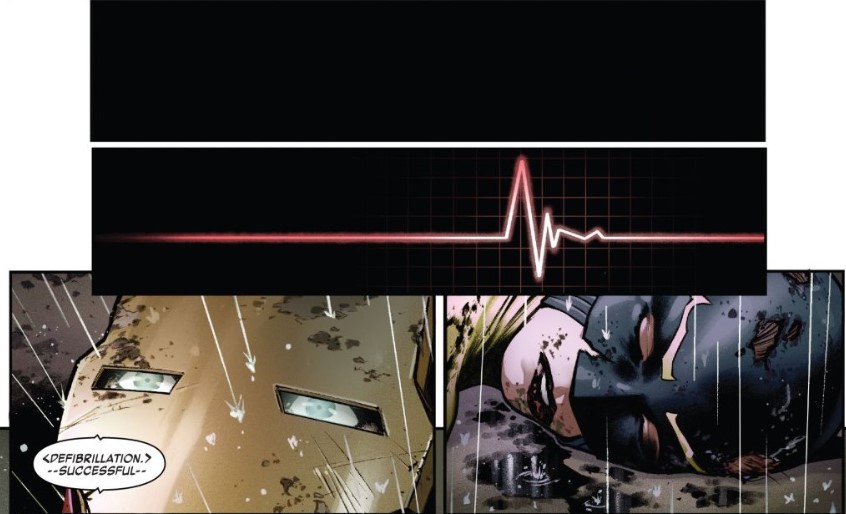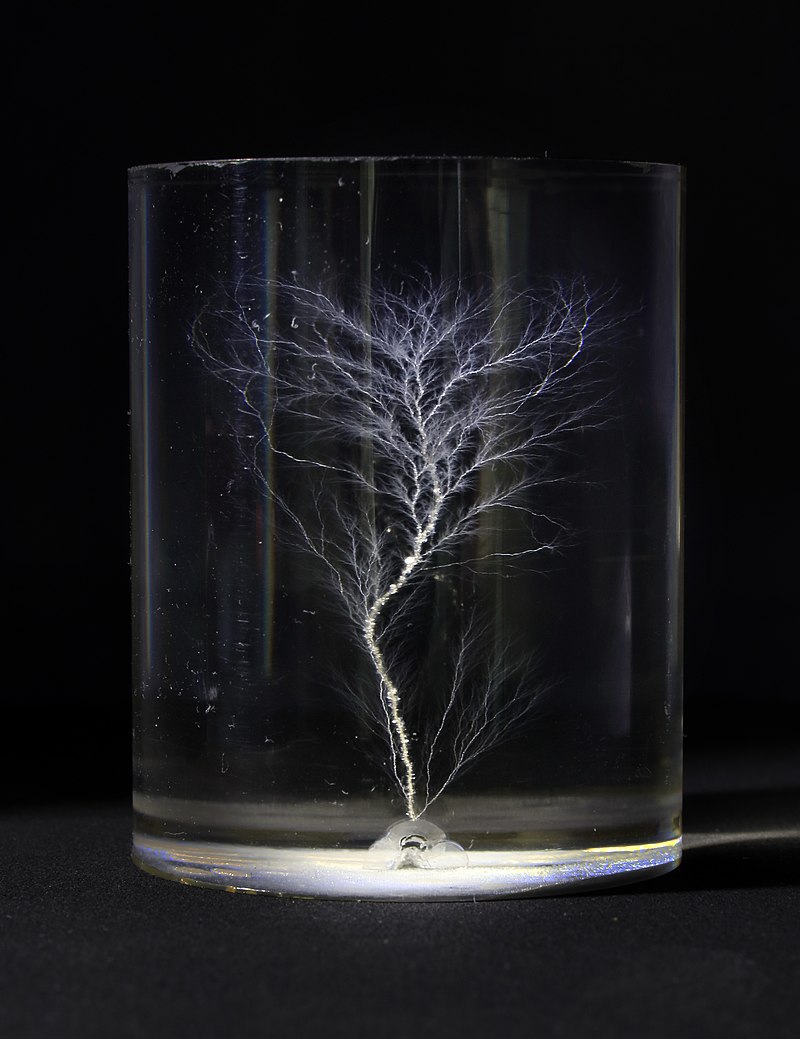Real quick – new Iron Man series by Christopher Cantwell and Cafu. Issue #3: Korvac is back. As part of that reveal, both Iron Man and Patsy Walker (aka Hellcat) got hit by a massive bolt of lightning, directed at them by the aforementioned Korvac.
How bad was it?
Bad enough that Tony’s armor had to defibrillate his heart to get him going again. That bad. At the end of the issue, we didn’t know if Patsy was alive or dead.
Okay, so this week’s issue (#4) – hey, she’s alive! But – and here’s the thing, she’s got a fractal-shaped lightning pattern on the left side of her face as the result of Korvac’s zap. For Patsy, a former fashion model and someone who doesn’t like to have hundreds of thousands of volts of electricity shot through her, let’s just say she was pissed about the new marking.
Tony tries to blow it off, suggesting that maybe Reed (Richards, of the Fantastic Four) or someone else can make sure it won’t scar, but this is comics…when a villain “marks” you, it’s most likely they’re not done with you. Slight spoiler – Korvac isn’t done with Patsy.
But let’s talk about that marking on Patsy’s face. That’s a thing.
Patsy’s face is showing a Lichtenberg figure, a natural phenomenon that happens when high voltage pushes through something that is normally an insulator. In skin, this happens as the high voltage electricity travels on the path of least resistance – most likely the surface of blood vessels near the skin. Often the vessels themselves will burst, but the pattern is caused by the heat from the electricity as it presses forward, trying to keep moving, despite traveling in a material that doesn’t conduct it very well.
Super-short version: when electricity is slowed in its motion, it releases heat. Think of a filament in a light bulb or a heating element in a toaster. Both are designed with high resistance – such that the electricity must slow down as it travels through them. The slower the electricity (the higher the resistance) the more heat produced. All in all, the skin is a pretty good insulator, and even though the near-surface blood vessels are better conductors than the neighboring skin, the pathway along the vessels slows the electricity enough to generate heat and cause very localized, superficial burns in a very distinctive pattern.
In reality, Lichtenberg figures on human skin have a very organic look because they’re following blood vessels or other (relatively) low-resistance pathways. Patsy’s look a little more…geometric, which to be fair, could be some artistic license on Cafu’s part, or perhaps (and probably a little more likely) being a visual signal of some kind of “infection” from Korvac which Tony didn’t get because…armor.

Korvac shows Iron Man and Patsy a shockingly good time (c) Marvel
This particular branching pattern was first observed by German physicist Georg Christoph Lichtenberg who then went on to create them by sending high voltage electricity through insulators that had powered materials on their surface. The heat would cause areas of the powder to burn, and Licehtnberg would then press a piece of paper against the insulator, transferring the pattern.
Lichtenberg’s discovery and observations were the seeds of the current field of plasma physics which…again, slight spoiler, is something that Korvac is just crazy for, as evidenced by his work to capture lightning.
And speaking of the Korvac-made/channeled lightning that hit Patsy…yeah, okay, getting hit by that kind of energy in comics is like…Tuesday. In reality, walking away from a lightning strike with minor Lichtenberg marking isn’t unheard of, but it is a very lucky break. Lightning in a human body wreaks havoc often starting with the eardrums rupturing, and then with the nervous and cardiovascular systems (it was strong enough to cause cardiac arrest in Tony, remember – which is insanely serious for a guy who’s had some not-so-minor heart issues over the years,…but okay, yeah…we’re not here to talk about Tony…), and most often results in a loss of consciousness and loss of memory surrounding the event itself. Long-term health effects, such as cardiovascular, neurological, and psychological problems aren’t uncommon, either.

In many cases, lightning strikes can result in cardiac arrest – like this time. (c) Marvel
Aside from the occasional victim of a lightning strike getting them, the figures and patterns are more common than you might think – they’re often found near where lightning has struck, and can be spotted easily on golf courses, and can be seen in the presence of fulgurite on beaches – mineral deposits formed by lightning strikes. The intense heat causes the materials to fuse into a network of tubes that resemble glass. The tubes spread out from the point of the strike in the characteristic, fractal-type pattern.
Many artists are currently creating amazing-looking works of art using high voltage passed into insulators to create the Lichtenberg figures. Examples of the characteristic branching shape can be found on many wooden pieces while sending beams of electrons (in short, controlled, artisanal lightning) into acrylic blocks points out an important reminder about the effect – it happens in three dimensions, rather than being limited to the two where we most often see it.

By Jan1959 – Own work, CC BY-SA 4.0, https://commons.wikimedia.org/w/index.php?curid=91416039
Oh, and Tony’s suggestion that he might be able to get someone that will make sure it doesn’t scar? He’s operating out of an abundance of caution for sure – most Lichtenberg figures on the skin can fade in as little 24-48 hours, but there can be underlying nerve issues, given the massive blast of electricity that was in the neighborhood.
In Patsy’s case? Comic book time being what it is and all, and that strong possibility she’s somehow “infected” by Korvac, hers might stick around a little bit longer. Future issues will tell.
References:
Dutta, Bornali. “Lichtenberg Figure and Lightning.” Indian Journal of Dermatology, Medknow Publications & Media Pvt Ltd, 2016, www.ncbi.nlm.nih.gov/pmc/articles/PMC4763624/.
Ocak, T., et al. “Two Cases of Lightning Strikes Resulting in Lichtenberg Figures.” Dermatologica Sinica, No Longer Published by Elsevier, 22 Mar. 2013, www.sciencedirect.com/science/article/pii/S1027811713000219.
Port, Jake. “How to Catch Lightning: the Magic of Lichtenberg Figures.” Cosmos Magazine, 30 Apr. 2020, cosmosmagazine.com/physics/how-to-catch-lightning-the-magic-of-lichtenberg-figures/.
Are you a science teacher or a science communicator who spotted a quick bit of science somewhere in pop culture and would like to do your own short “Science Class” article? Drop us a line – matt (at) thescienceof.org!







